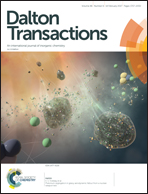Low temperature heat capacity, standard entropy, standard enthalpy and magnetic property: a new 1D CuII coordination polymer incorporating tetrazole-1-acetic acid and p-nitrobenzoic acid†
Abstract
A new 1D CuII coordination polymer, formulated as {[Cu(TZA)(PNA)]·H2O}n (1) (HTZA = tetrazole-1-acetic acid, HPNA = p-nitrobenzoic acid), was synthesized and structurally characterized. Thermogravimetric analysis demonstrated that the main frame of 1 exhibited good thermostability up to 473 K. The non-isothermal kinetics for the first exothermic process of 1 were studied by Kissinger and Ozawa methods. The magnetic study revealed that 1 possessed antiferromagnetic exchange interactions between CuII ions through the carboxyl-bridge. The low-temperature (1.9 to 300 K) heat capacity of 1 was measured using the heat-capacity option of a Quantum Design Physical Property Measurement System (PPMS). In addition, the thermodynamic functions in the experimental temperature range were derived by fitting the heat-capacity data to a series of theoretical and empirical models. The standard entropy and standard enthalpy of 1 were respectively calculated to be 411.37 ± 4.11 J mol−1 K−1 and 60.21 ± 0.60 kJ mol−1.



 Please wait while we load your content...
Please wait while we load your content...